Amazon’s first quarter earnings have made one thing abundantly clear: COVID-19 has caused sales to soar as people shop from the safety of their homes. However, Amazon has been struggling to meet the immense surge in the volume of orders and contend with worker absences during the pandemic. In response, Amazon.com, Inc. is retooling its website to do the opposite of what made it one of the world’s most powerful and dominant companies: it’s trying to make you to shop less.
Weeks of no deals
With demand outpacing the supply chain networks, Amazon didn’t have a choice but to tweak its online shopping experience to slow down site traffic.
Amazon’s homepage was the first indication that it was finding ways to cut down on demand. They were featuring digital products, Kindle eBooks, Amazon music, and Amazon Prime videos and there were far fewer lifestyle and consumer products being shown on their featured pages. Amazon also drove fewer products to shoppers’ carts by no longer displaying ‘frequently bought together’ items and other complementary product suggestions.
Fewer ads
Another way Amazon tried to reduce its sales was by trying to cut back on overall site traffic.
One big way Amazon normally brings outside shoppers to its site is by buying a huge amount of advertising on Google Search engine. It stopped much of that spending in March. In the pre-COVID past, you would see Amazon product listings and Google Adwords ads, all driving traffic to Amazon.
Though it’s been Google’s largest client, Amazon has essentially turned off it’s advertising, cutting into Google’s sales as well. It seems like this is all connected to their goal to slow down the amount of site traffic so that they can catch their breath.
Limits on incoming products
To cut on the burden on its fulfillment centers, Amazon stopped allowing sellers to send non-essential items into its warehouses altogether in March. It took steps to dampen demand for non-essential products. Their network pivoted to shipping high priority products within one to four days, and extending promises on non-priority items.
Less consumer reliance on Amazon
As customers find products run out of stock in Amazon, they often turn to the competition. The risk that Amazon creates for itself is that those customers will start shopping somewhere other than Amazon.
Walmart is one competitor that also had a surge in demand. Its app has seen a record number of downloads at the end of April, weeks ahead of schedule and has launched express delivery where shoppers pay an additional $10 surcharge for guaranteed two-hour delivery on 760,000 items.
The question is, does Amazon even mind losing customers to competitors right now?
They wouldn’t want other suppliers to fill the space they’ve left, but it appears that Amazon is so overwhelmed at the moment that they can’t afford the time to even think about competition.
Going forward
With Amazon giving its workers the ability to work from home until 2021, one can only speculate as to how much capacity Amazon will be able to fulfill over the coming months, even as governments begin lifting social distancing guidelines.








